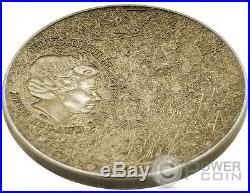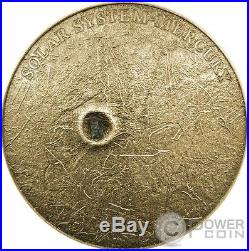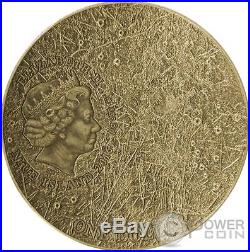solar
21st April
2016





31.1 (1 oz). This beautiful 1 Oz Silver coin, with a real meteorite and yellow Antique Finsh quality, is the second issue of the series “Solar System”. The coin depicts the Mercury surface on both sides, with a concave shape and the insert is a real piece of the NWA 8409 Meteorite. The coin is housed in a prestigious wooden box with Certificate of Authenticity. Extremely low mintage of 686 pieces worldwide! The reverse of the coin depicts the Mercury surface, with very realistic details. What makes this coin unique is a real meteorite called NWA 8409, fallen on Earth in Northwest Africa, inlaid on the coin. On top of the coin the inscription “Solar System Mercury” and on the obverse side the effigy of Her Majesty Queen Elizabeth II. Mercury Mercury is the smallest planet in the Solar System and the one closest to the Sun, with an orbital period of about 88 Earth days, which is much faster than any other planet in the Solar System. Seen from Earth, it appears to move around its orbit in about 116 days. It has no known natural satellites. It is named after the Roman deity Mercury, the messenger to the gods. Partly because it has almost no atmosphere to retain heat, Mercury’s surface temperature varies diurnally more than any other planet in the Solar System, ranging from 100 K (-173 °C; -280 °F) at night to 700 K (427 °C; 800 °F) during the day in some equatorial regions. The poles are constantly below 180 K (-93 °C; -136 °F). Mercury’s axis has the smallest tilt of any of the Solar System’s planets (about 1/30 of a degree). However it has the largest orbital eccentricity: at aphelion, Mercury is about 1.5 times as far from the Sun as it is at perihelion. Mercury’s surface is heavily cratered and similar in appearance to the Moon, indicating that it has been geologically inactive for billions of years. Mercury is gravitationally locked and rotates in a way that is unique in the Solar System. As seen relative to the fixed stars, it rotates on its axis exactly three times for every two revolutions it makes around the Sun. As seen from the Sun, in a frame of reference that rotates with the orbital motion, it appears to rotate only once every two Mercurian years. An observer on Mercury would therefore see only one day every two years. The item “SOLAR SYSTEM MERCURY NWA 8409 Meteorite Silver Coin 1$ Niue 2016″ is in sale since Monday, April 18, 2016. This item is in the category “Coins & Paper Money\Coins\ World\Australia & Oceania\South Pacific”. The seller is “powercoin_italy” and is located in Roma. This item can be shipped worldwide.
- Circulated/Uncirculated: Uncirculated
- Year: 2016
- Composition: Silver
- Country/Region of Manufacture: Niue
Comments Off
13th April
2016





31.1 (1 oz). This beautiful 1 Oz Silver coin, with a real meteorite and yellow Antique Finsh quality, is the second issue of the series “Solar System”. The coin depicts the Mercury surface on both sides, with a concave shape and the insert is a real piece of the NWA 8409 Meteorite. The coin is housed in a prestigious wooden box with Certificate of Authenticity. Extremely low mintage of 686 pieces worldwide! The reverse of the coin depicts the Mercury surface, with very realistic details. What makes this coin unique is a real meteorite called NWA 8409, fallen on Earth in Northwest Africa, inlaid on the coin. On top of the coin the inscription “Solar System Mercury” and on the obverse side the effigy of Her Majesty Queen Elizabeth II. Mercury Mercury is the smallest planet in the Solar System and the one closest to the Sun, with an orbital period of about 88 Earth days, which is much faster than any other planet in the Solar System. Seen from Earth, it appears to move around its orbit in about 116 days. It has no known natural satellites. It is named after the Roman deity Mercury, the messenger to the gods. Partly because it has almost no atmosphere to retain heat, Mercury’s surface temperature varies diurnally more than any other planet in the Solar System, ranging from 100 K (-173 °C; -280 °F) at night to 700 K (427 °C; 800 °F) during the day in some equatorial regions. The poles are constantly below 180 K (-93 °C; -136 °F). Mercury’s axis has the smallest tilt of any of the Solar System’s planets (about 1/30 of a degree). However it has the largest orbital eccentricity: at aphelion, Mercury is about 1.5 times as far from the Sun as it is at perihelion. Mercury’s surface is heavily cratered and similar in appearance to the Moon, indicating that it has been geologically inactive for billions of years. Mercury is gravitationally locked and rotates in a way that is unique in the Solar System. As seen relative to the fixed stars, it rotates on its axis exactly three times for every two revolutions it makes around the Sun. As seen from the Sun, in a frame of reference that rotates with the orbital motion, it appears to rotate only once every two Mercurian years. An observer on Mercury would therefore see only one day every two years. The item “SOLAR SYSTEM MERCURY NWA 8409 Meteorite Silver Coin 1$ Niue 2016″ is in sale since Monday, April 11, 2016. This item is in the category “Coins & Paper Money\Coins\ World\Australia & Oceania\South Pacific”. The seller is “powercoin_italy” and is located in Roma. This item can be shipped worldwide.
- Circulated/Uncirculated: Uncirculated
- Year: 2016
- Composition: Silver
- Country/Region of Manufacture: Niue
Comments Off
18th March
2016








Minted for the country of Nuie and the 5 dollar denomination of New Zealand. There will be a series of these with space shuttle parts and things that have been in outer space. With only a mintage of 1000 these rare coins will only increase in value. The item “2016 $5 Solar System 1 Oz Silver Proof With Meteorite Glass” is in sale since Monday, February 01, 2016. This item is in the category “Coins & Paper Money\Bullion\Silver\Coins”. The seller is “pokerkurt1″ and is located in Sun City, California. This item can be shipped to United States, to Canada, to United Kingdom, DK, RO, SK, BG, CZ, FI, HU, LV, LT, MT, EE, to Australia, GR, PT, CY, SI, to Japan, SE, ID, to Belgium, to France, to Hong Kong, to Ireland, to Netherlands, PL, to Spain, to Italy, to Germany, to Austria, SG, NO, SA, AE, BH, HR, MY, TR, CL, CO, CR, DO, PA, TT, GT, SV, HN, JM.
- Coin: $ 5.00 New Zealand
- Precious Metal Content: 1 oz
- Year: 2016
- Country/Region of Manufacture: Niue
Comments Off
15th February
2016






31.1 (1 oz). Beautiful 1 oz Silver coin in ultra high relief with a real lunar meteorite, first issue of the series “Solar System”. The coin depicts the moon on both side with a concave shape and the metorite is a real piece of the NWA 8609 found in Northwest Africa. The coin is housed in a prestigious wooden box with Certificate of Authenticity. Extremely low mintage of 686 pieces worldwide. The obverse of the dome shaped coin depicts in ultra high relief the moon surface, with very realistic details and deep craters. What makes this coin unique is a real moon meteorite called NWA 8609, fallen on Earth in Northwest Africa, inlaid on the coin. On top of the coin the inscription “Solar System Moon” and on the obverse side the effigy of Her Majestic Queen Elizabeth II. Moon and the meteorite NWA 8609 The Moon (Latin: Luna) is Earth’s only natural satellite. Although not the largest natural satellite in the Solar System, among the satellites of major planets it is the largest relative to the size of the object it orbits (its primary). It is the second-densest satellite among those whose densities are known (after Jupiter’s satellite Io). The Moon is thought to have formed approximately 4.5 billion years ago, not long after Earth. Although there have been several hypotheses for its origin in the past, the current most widely accepted explanation is that the Moon formed from the debris left over after a giant impact between Earth and a Mars-sized body. The Moon is in synchronous rotation with Earth, always showing the same face with its near side marked by dark volcanic maria that fill between the bright ancient crustal highlands and the prominent impact craters. It is the second-brightest regularly visible celestial object in Earth’s sky (after the Sun), as measured by illuminance on Earth’s surface. Although it can appear a very bright white, its surface is actually dark, with a reflectance just slightly higher than that of worn asphalt. Its prominence in the sky and its regular cycle of phases have, since ancient times, made the Moon an important cultural influence on language, calendars, art, and mythology. The Moon’s gravitational influence produces the ocean tides and the slight lengthening of the day. The Moon’s current orbital distance is about thirty times the diameter of Earth, causing it to have an apparent size in the sky almost the same as that of the Sun. This allows the Moon to cover the Sun nearly precisely in total solar eclipse. This matching of apparent visual size is a coincidence. The Moon’s linear distance from Earth is currently increasing at a rate of 3.82 ± 0.07 centimetres (1.504 ± 0.028 in) per year, but this rate is not constant. Physical characteristics: Single stone, dark brown, irregular weathered surface. Saw cut reveals a range of light and dark mm-size clasts and mineral fragments set in a dark-gray matrix. Agee, UNM Microprobe examination of a polished mount shows a fragmental breccia of plagioclase, olivine, and pyroxene grains, also feldspathic clasts, melt clasts, and microgabbro clasts. Accessory Fe-Ni metal, ilmenite, and apatite. The item “SOLAR SYSTEM MOON NWA 8609 Lunar Meteorite High Relief Silver Coin 1$ Niue 2015″ is in sale since Monday, June 15, 2015. This item is in the category “Coins & Paper Money\Coins\ World\Australia & Oceania\South Pacific”. The seller is “powercoin_italy” and is located in Roma. This item can be shipped worldwide.
- Circulated/Uncirculated: Uncirculated
- Year: 2015
- Composition: Silver
- Country/Region of Manufacture: Niue
Comments Off

